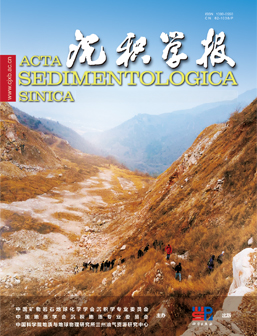Characteristics of Symbiosis System of Dolomite Evaporite in Leikoupo Formation of Triassic in Northwest Sichuan and Paleogeographic Reconstruction
doi: 10.14027/j.issn.1000-0550.2024.030
- Received Date: 2023-07-28
- Available Online: 2024-04-09
-
Key words:
- Sichuan Basin /
- Leikoupo Formation /
- Dolomite-Evaporite symbiotic system /
- Sedimentary environment /
- Paleogeographic pattern
Abstract: The dolomite evaporite symbiotic system is widely distributed during the Middle Triassic period in the Sichuan Basin, but its sedimentary characteristics lack systematic characterization. The development and distribution patterns and main controlling factors are still unclear. Based on drilling, core, and seismic data, this article characterizes the sedimentary characteristics of the developed dolomite evaporite symbiotic system in the study area at multiple scales, elucidates the genetic mechanisms of different types of symbiotic systems, and further reveals their spatiotemporal distribution patterns and main controlling factors. The research results indicate that: (1) Four types of symbiotic systems are mainly developed in the Leikoupo Formation in the northwest Sichuan Basin: thick layer of dolomite with thin layer of evaporite, interlayer of dolomite and evaporite, thick layer of evaporite with thin layer of dolomite, and overlapping of thick layer of evaporite with thick layer of dolomite. They are respectively formed in gypsum containing lagoons, cloud containing gypsum containing lagoons, gypsum salt lakes, and gypsum salt basins. Among them, thick layer of dolomite mixed with thin layer of evaporite is widely distributed in the four periods of Leikoupo. Thick layer of evaporite mixed with thin layer of dolomite, and the overlap of thick layer of evaporite and thick layer of dolomite is the most developed in the central part of the Leisan and Leisi sedimentary periods of the basin. (3) The uplift of the Longmenshan Island Chain on the west side resulted in southeast compression of the basin, while the uplift of the Xuefeng Mountain on the east side restricted the southern migration of the Luzhou Kaijiang ancient uplift. The southern subduction of the Qinling Mountains jointly formed a nearly northeast southwest structural pattern in the Sichuan Basin, controlling the overall distribution of gypsum and symbiotic systems in a northeast southwest direction. (4) Affected by the significant uplift of the Luzhou Kaijiang ancient uplift, the later subsidence center of the Leikoupo Formation migrated to the west, and the gypsum sedimentary center and four symbiotic systems correspondingly developed from early dispersion to later concentration and migrated to the west. Under the constraints of different types of symbiotic systems, the paleogeography of the Leikoupo Formation was reconstructed for four periods. The above research provides a new understanding for the study of the symbiotic system of dolomite evaporite in the northwest Sichuan region, and also has a guiding role in the reconstruction of regional paleogeography.
| Citation: | Characteristics of Symbiosis System of Dolomite Evaporite in Leikoupo Formation of Triassic in Northwest Sichuan and Paleogeographic Reconstruction[J]. Acta Sedimentologica Sinica. doi: 10.14027/j.issn.1000-0550.2024.030 |






 DownLoad:
DownLoad: